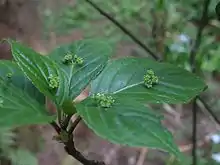Helwingia
The genus Helwingia consists of shrubs or rarely small trees native to eastern Asia, the Himalayas, and northern Indochina. It is the only genus in the family Helwingiaceae.[2][3]
| Helwingia | |
|---|---|
 | |
| Helwingia japonica var. japonica | |
| Scientific classification | |
| Kingdom: | Plantae |
| Clade: | Tracheophytes |
| Clade: | Angiosperms |
| Clade: | Eudicots |
| Clade: | Asterids |
| Order: | Aquifoliales |
| Family: | Helwingiaceae Decne.[1] |
| Genus: | Helwingia Willd. |
The plants have alternate, evergreen or deciduous leaves and small inflorescences that are epiphyllous (growing from the leaf surface). During development, the flowers appear separate from the leaves, but eventually fuse with the leaf midrib.[4] Flowers are small and yellow-green or purple, followed by red or black berries. Plants are dioecious.
The APG II classification (2003) places them in the order Aquifoliales, along with the hollies and Phyllonomaceae, which also has epiphyllous flowers.[5]
The family Helwingiaceae does not exist in the Cronquist classification (1981), which places this genus in the Cornaceae (dogwood family). Helwingia has also previously been placed in the Araliaceae (ginseng family).[6]
- Species[2]
- Helwingia chinensis Batalin - Thailand, Myanmar, China: Gansu, Guizhou, Hubei, Hunan, Shaanxi, Sichuan, Tibet, Yunnan
- Helwingia himalaica Hook.f. & Thomson ex C.B.Clarke - Thailand, Myanmar, Bhutan, Nepal, India: Assam, Sikkim, China: Tibet, Chongqing, Guangdong, Guangxi, Guizhou, Hubei, Hunan, Sichuan, Yunnan
- Helwingia japonica (Thunb.) F.Dietr. - Japan (incl. Ryukyu Islands), Korea, Taiwan, Myanmar, Bhutan, Vietnam, India: Assam, Sikkim, China: Anhui, Fujian, Gansu, Guangdong, Guangxi, Guizhou, Henan, Hubei, Hunan, Jiangsu, Jiangxi, Shaanxi, Shandong, Shanxi, Sichuan, Yunnan, Zhejiang
- Helwingia omeiensis (W.P.Fang) H.Hara & S.Kuros. - China: Gansu, Guangxi, Guizhou, Hubei, Hunan, Shaanxi, Sichuan, Yunnan
References
- Angiosperm Phylogeny Group (2009). "An update of the Angiosperm Phylogeny Group classification for the orders and families of flowering plants: APG III". Botanical Journal of the Linnean Society. 161 (2): 105–121. doi:10.1111/j.1095-8339.2009.00996.x. Archived from the original (PDF) on 2017-05-25. Retrieved 2013-06-26.
- Kew World Checklist of Selected Plant Families
- Flora of China Vol. 14 Page 227 青荚叶属 qing jia ye shu Helwingia Willdenow, Sp. Pl. 4: 634, 716. 1806, nom. cons., not Helvingia Adanson (1763).
- Dickinson, Timothy A.; Sattler, Rolf (1975). "Development of the Epiphyllous Inflorescence of Helwingia japonica (Helwingiaceae)". American Journal of Botany. 62 (9): 962–973. doi:10.2307/2441641. ISSN 0002-9122. JSTOR 2441641.
- Dickinson, T. A.; Sattler, R. (1974). "Development of the epiphyllous inflorescence of Phyllonoma integerrima (Turcz.) Loes.: implications for comparative morphology*". Botanical Journal of the Linnean Society. 69 (1): 1–13. doi:10.1111/j.1095-8339.1974.tb01609.x. ISSN 1095-8339.
- Hara, Hiroshi; Kurosawa, Sachiko (1975). Ohashi, H. (ed.). "A Revision of the Genus Helwingia". Flora of the Eastern Himalayas. 3: 393–413.
External links
| Wikimedia Commons has media related to Helwingia. |
- Aquifoliales - Angiosperm Phylogeny Website, consulted 2007-01-26.
- Helwingiaceae, Watson, L., and Dallwitz, M.J. 1992 onwards. The families of flowering plants: descriptions, illustrations, identification, and information retrieval. Version: 29 July 2006.
- Also see Cornaceae
- Helwingiaceae from NCBI-Taxonomy
- Helwingiaceae, USDA, ARS, National Genetic Resources Program. Germplasm Resources Information Network - (GRIN Online Database). National Germplasm Resources Laboratory, Beltsville, Maryland. Consulted 2007-01-26.